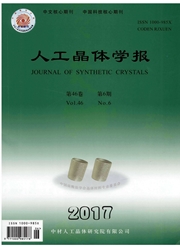

 中文摘要:
中文摘要:
采用脉冲激光沉积(PLD)法分别在SrTiO3(100)、LaAlO3(100)和MgO(100)单晶基片上制备了双层钙钛矿锰氧化物La1.3Sr1.7Mn2O7(LSMO)薄膜。X射线衍射谱表明三个样品均沿衬底的晶向择优生长;原子力显微镜显示薄膜表面均光滑致密。采用标准四探针法对薄膜的阻温特性进行了研究,发现SrTiO3(100)和LaAlO3(100)基片上生长的薄膜呈现出明显的金属一绝缘体转变,转变温度分别为340K和330K。而在MgO基片上显示绝缘体态,无金属.绝缘体转变。结合阻温曲线的拟合及薄膜与衬底的晶格失配计算,从薄膜应力和激活能变化的角度分析了样品出现不同阻温特性的内在机制。
 英文摘要:
英文摘要:
Double perovskite manganese oxides Lal.3 Sr1.7 Mn207 (LSMO) epitaxial thin films were deposited on the SrTiO3 (100), LaAIO3 (100) and MgO (100) single-crystal substrates by pulse laser deposition (PLD) method. XRD results show that three samples exhibit fine growth with accordance with the orientations of the substrates; atomic force microscopy show that all the films exhibit a dense and smooth surface. The resistance-temperature characteristic of the films were measured using the standard four-probe technique and it was found that the thin films grown on SrWiO3 and LaAIO3 substrates exhibite obvious metal-insulator transition, the transition temperatures at 340 K and 330 K, respectively. However, the film deposited on MgO substrate performs insulator behavior without metal-insulator transition. Combined with the lattice mismatch and the fit of resistance-temperature curves, the intrinsic mechanism of different resistance-temperature characteristics were analyzed from the angle of the stress and activation energy.
 同期刊论文项目
同期刊论文项目
 同项目期刊论文
同项目期刊论文
 Transport and magnetoresistance effect in an oxygen-deficient SrTiO3/La0.67Sr0.33MnO3 heterojunction
Transport and magnetoresistance effect in an oxygen-deficient SrTiO3/La0.67Sr0.33MnO3 heterojunction Suppression of photovoltaic effect by magnetic field in Pr0.65(Ca0.75Sr0.25)0.35MnO3/Nb:SrTiO3 heter
Suppression of photovoltaic effect by magnetic field in Pr0.65(Ca0.75Sr0.25)0.35MnO3/Nb:SrTiO3 heter Bubbles engulfment and entrapment by cellular and dendritic interfaces during directional solidifica
Bubbles engulfment and entrapment by cellular and dendritic interfaces during directional solidifica Morphological determination of forced shear flow rate during directional solidification of succinoni
Morphological determination of forced shear flow rate during directional solidification of succinoni Morphological evolution of the solid-liquid interface near grain boundaries during directional solid
Morphological evolution of the solid-liquid interface near grain boundaries during directional solid X-ray diffraction, atomic force microscopy and raman spectroscopy studies of microstructure of BiFeO
X-ray diffraction, atomic force microscopy and raman spectroscopy studies of microstructure of BiFeO Orientation-dependent piezoelectric properties in lead-free epitaxial 0.5BaZr(0.2)Ti(0.8)O(3)-0.5Ba(
Orientation-dependent piezoelectric properties in lead-free epitaxial 0.5BaZr(0.2)Ti(0.8)O(3)-0.5Ba( Growth and characterization of lead-free piezoelectric BaZr0.2Ti0.8O3-Ba0.7Ca0.3TiO3 thin films on S
Growth and characterization of lead-free piezoelectric BaZr0.2Ti0.8O3-Ba0.7Ca0.3TiO3 thin films on S Determination of the effective mass and nanoscale electrical transport in La-doped BaSnO3 thin films
Determination of the effective mass and nanoscale electrical transport in La-doped BaSnO3 thin films Composition dependence of ferroelectric and piezoelectric properties of epitaxial (1-x)Ba(Zr0.2Ti0.8
Composition dependence of ferroelectric and piezoelectric properties of epitaxial (1-x)Ba(Zr0.2Ti0.8 Multiferroic and resistive switching behaviors in BiFe0.95Cr0.05O3 thin films deposited on Pt/Ti/SiO
Multiferroic and resistive switching behaviors in BiFe0.95Cr0.05O3 thin films deposited on Pt/Ti/SiO 期刊信息
期刊信息
